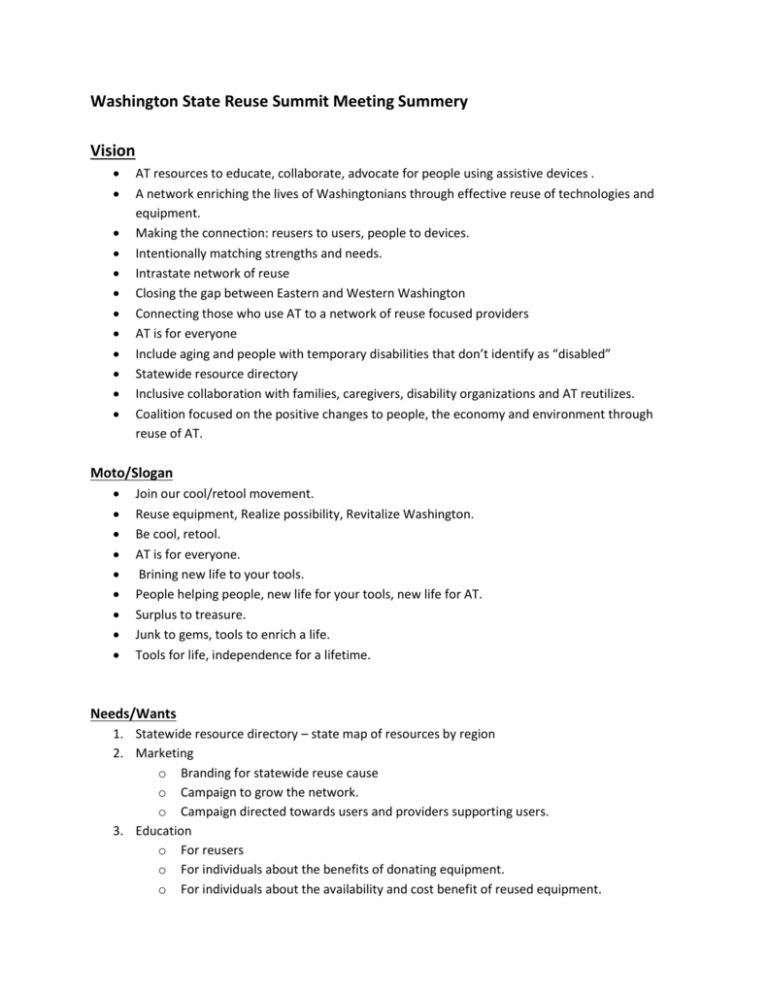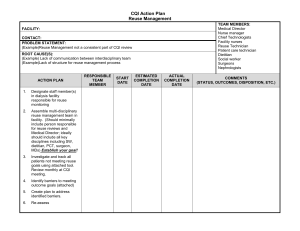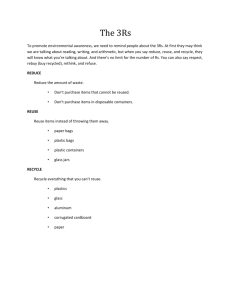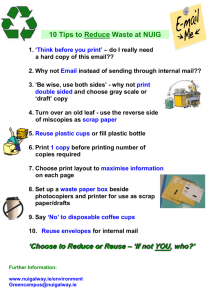Document 7827872
advertisement

Washington State Reuse Summit Meeting Summery Vision AT resources to educate, collaborate, advocate for people using assistive devices . A network enriching the lives of Washingtonians through effective reuse of technologies and equipment. Making the connection: reusers to users, people to devices. Intentionally matching strengths and needs. Intrastate network of reuse Closing the gap between Eastern and Western Washington Connecting those who use AT to a network of reuse focused providers AT is for everyone Include aging and people with temporary disabilities that don’t identify as “disabled” Statewide resource directory Inclusive collaboration with families, caregivers, disability organizations and AT reutilizes. Coalition focused on the positive changes to people, the economy and environment through reuse of AT. Moto/Slogan Join our cool/retool movement. Reuse equipment, Realize possibility, Revitalize Washington. Be cool, retool. AT is for everyone. Brining new life to your tools. People helping people, new life for your tools, new life for AT. Surplus to treasure. Junk to gems, tools to enrich a life. Tools for life, independence for a lifetime. Needs/Wants 1. Statewide resource directory – state map of resources by region 2. Marketing o Branding for statewide reuse cause o Campaign to grow the network. o Campaign directed towards users and providers supporting users. 3. Education o For reusers o For individuals about the benefits of donating equipment. o For individuals about the availability and cost benefit of reused equipment. Barriers & Solution (Barriers are listed in bold and solutions are bulleted under the barrier) 1. Transportation/supply chain from donors to reuse orgs to new users o Universities, Schools of engineering – can create a supply chain matrix. 2. Transportation in disaster recovery o VOAD – Volunteer Organizations Active in Disasters 3. Transportation from reusers to users. o Large items Long haul carriers State DOT National Guard Depot stations Goodwill, churches, CSB Rotary Club – First Harvest trucks UPS – organized in Seattle o Small items Network of volunteer drivers Statewide fund for volunteer mileage reimbursement Library systems Volunteer CHORE Agency Goodwill Drop-off locations (depots) where reuse orgs can schedule monthly pick-ups. Aging and Adult Care, Division of Aging RideShare.org 4. Storage o Off-site warehouses o Ship overstocked items oversees with international organizations o Public storage facilities 5. Donations of equipment o Work with funders and healthcare providers to educate people how they can donate equipment when they no longer need it. o Work with State Surplus and Waste Management to develop a system of diverting goods. o Thrift Store networks around the state o Internet sites - Spidering websites o Education and Marketing o Identifying important equipment needs o Funding Equipment drives o Drop-off sites (at libraries, community centers) 6. Funding for reuse organizations o In-kind donations o Gants for capital improvements - “the key is getting the invitations” Allen Foundation Gate Foundation o Suggested monetary donations from users o Fees o Fundraising 7. Repair of equipment after distribution additional costs associated with services/fitting of reused equipment o Micro loans through Washington Access Fund o Create a commercial entity for repairs 8. Properly matching device to individuals o Specializing in equipment for your expertise o Working with professional qualified to provide services (i.e.: Audiologists, SLPs, P/Ts, O/Ts) 9. Too many “hats” for reuse staff o Using volunteers o Creating/using an on-line inventory tracking system o Wireless head-sets so staff can multi-task, checking inventory and talking with customers o Authorize database 10. Recruiting, matching, training and retaining volunteers o Use Volunteer Centers for resources HandsOn Network, United Way o Boeing volunteers for technical repairs o Connecting with service learning groups in Community Colleges and other Higher Ed o Connecting with School Districts to get students involved in reuse 11. Users lack of Knowledge about Reuse Resources o Comprehensive Marketing Plan Hands-on demos and expos with reused equipment On-line resources - website with statewide map/directory of resources Print materials to be shared among the network Equipment drives in “natural” or network organized venues 12. Users fear of Used equipment o Develop and use network-wide best practices in refurbishment, sanitation and Matching AT to consumers o Educate consumers 13. Legal issues (privacy, confidentiality, liability) o Work with legislators to advocate for Good Samaritan Laws o Work with Bar Association and lawyers to draft liability policies. 14. No current “tickler” system to ID needs to access devices o Network of reutilizers to match needs with suppliers 15. Restrictive environments (i.e. nursing homes) o Identifying and reaching out to them. o Marketing Actions WATAP o Identify inventory tracking – work with groups to update or recommend current systems o Host bi-monthly teleconferences o Schedule future Network meeting o Send out survey of critical issues that need sub-committees formed to address. o Send out contact list of Summit participants o Set-up online forum and invite Summit participants Marketing/Branding Subgroup o “Who We Are” Meeting: Jack, Irene, Jennifer and Sam (anyone else who responds in survey) Identify other people who need to be at the table. Washington Access Fund o Micro loans and “scenarios” for refurbished AT, repairs, trainings, batteries.







